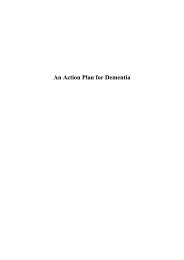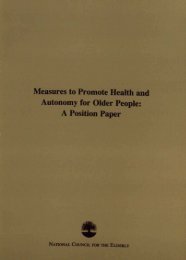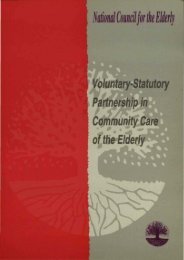From Ageism to Age Equality: Addressing the Challenges ...
From Ageism to Age Equality: Addressing the Challenges ...
From Ageism to Age Equality: Addressing the Challenges ...
You also want an ePaper? Increase the reach of your titles
YUMPU automatically turns print PDFs into web optimized ePapers that Google loves.
membership of <strong>the</strong> Traveller community. The age ground under <strong>the</strong> Employment <strong>Equality</strong> Acts applies<strong>to</strong> all ages above <strong>the</strong> maximum age at which a person is statu<strong>to</strong>rily obliged <strong>to</strong> attend school. The ageground under <strong>the</strong> Equal Status Acts applies <strong>to</strong> people over 18 except for <strong>the</strong> provision of car insurance<strong>to</strong> licensed drivers under that age. Both Acts prohibit discrimination. Discrimination has a specificmeaning in <strong>the</strong> Acts. It is defined as <strong>the</strong> treatment of a person in a less favourable way than ano<strong>the</strong>rperson is, has been or would be treated in a comparable situation on any of <strong>the</strong> nine grounds whichexists, existed, may exist in <strong>the</strong> future or is imputed <strong>to</strong> <strong>the</strong> person concerned. Different types ofdiscrimination are covered including indirect discrimination and discrimination by association.Indirect discrimination happens where <strong>the</strong>re is less favourable treatment by impact or effect. It occurswhere people are, for example, refused a service not explicitly on account of a discrimina<strong>to</strong>ry reasonbecause of a provision, practice or requirement which <strong>the</strong>y find hard <strong>to</strong> satisfy. If <strong>the</strong> provision, practiceor requirement puts people who belong <strong>to</strong> one of <strong>the</strong> nine grounds at a particular disadvantage, <strong>the</strong>n<strong>the</strong> service providers will have indirectly discriminated unless <strong>the</strong> provision is objectively justified by alegitimate aim and <strong>the</strong> means of achieving that aim are appropriate and necessary.Discrimination by association happens where a person associated with ano<strong>the</strong>r person who belongs<strong>to</strong> one of <strong>the</strong> nine grounds is treated less favourably because of that association.Both Acts prohibit sexual harassment and harassment on <strong>the</strong> discrimina<strong>to</strong>ry grounds. Victimisation isalso prohibited. Both Acts require employers, educational and training bodies, service providers andproviders of accommodation <strong>to</strong> provide reasonable accommodation for people with disabilities.There is an exemption from this requirement under <strong>the</strong> Employment <strong>Equality</strong> Acts if <strong>the</strong> reasonableaccommodation imposes a disproportionate burden on <strong>the</strong> employer, and under <strong>the</strong> Equal Status Acts5if <strong>the</strong> reasonable accommodation costs more than a nominal cost. Both Acts allow positive action.Under <strong>the</strong> Employment <strong>Equality</strong> Acts employers can take steps with a view <strong>to</strong> ensuring full equalityin practice between employees on all nine grounds. Under <strong>the</strong> Equal Status Acts positive action isallowed in relation <strong>to</strong> disadvantaged groups and in relation <strong>to</strong> measures which cater for <strong>the</strong> specialneeds of persons.Both Acts impose a vicarious liability on employers and service providers in relation <strong>to</strong> discrimina<strong>to</strong>ryacts of employees and agents unless <strong>the</strong> employers or service providers <strong>to</strong>ok reasonably practicablesteps <strong>to</strong> prevent <strong>the</strong> discriminations. Such steps should include putting in place equality policies andprocedures <strong>to</strong> seek <strong>to</strong> prevent discrimination and harassment, and <strong>to</strong> address <strong>the</strong>se issues if <strong>the</strong>y arise.Both Acts contain a number of detailed exemptions. In <strong>the</strong> Employment <strong>Equality</strong> Acts <strong>the</strong>se includeexemptions that allow an employer <strong>to</strong> set different ages for <strong>the</strong> retirement of employees and <strong>to</strong> set aminimum age, not exceeding 18 years, in recruitment. In <strong>the</strong> Equal Status Acts <strong>the</strong>se include astatu<strong>to</strong>ry exemption that provides that nothing in <strong>the</strong> Act shall prohibit <strong>the</strong> taking of any action thatis required under statu<strong>to</strong>ry provision or court order.The provisions and <strong>the</strong> exemptions in <strong>the</strong>se Acts have <strong>to</strong> be read in <strong>the</strong> light of <strong>the</strong> EU EqualTreatment Directives which take precedence over Irish legislation. 11 Information booklets on <strong>the</strong> legislation are available from The <strong>Equality</strong> Authority, 2 Clonmel St, Dublin 2 or LoCall1890 245545.<strong>From</strong> <strong><strong>Age</strong>ism</strong> <strong>to</strong> <strong>Age</strong> <strong>Equality</strong>: <strong>Addressing</strong> <strong>the</strong> <strong>Challenges</strong>















